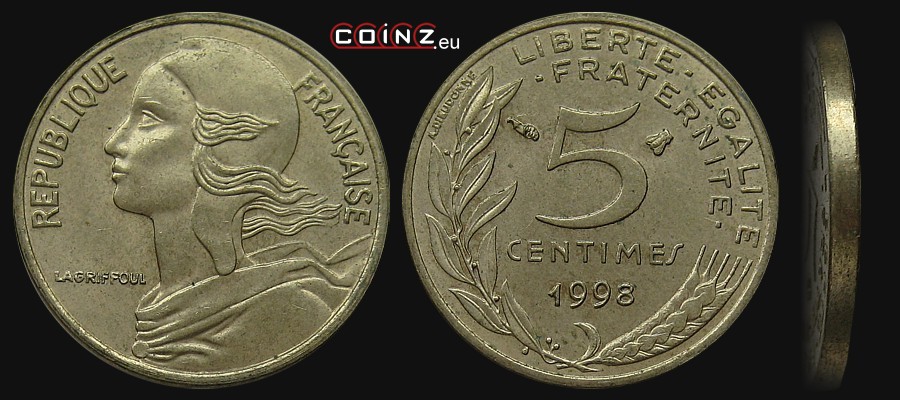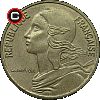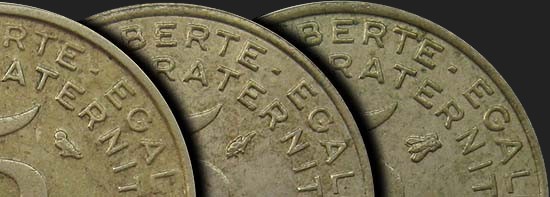5 centimes FRANCE (1966-2001)


| diameter: | weight: | thickness: | alloy: |
| 17.0 mm | 2.0 g | 1.4 mm | Cu92Al6Ni2 |
obverse:
in the coin centre personification of France - bust of Marianne in a Phrygian cap facing left; along the top edge: RÉPUBLIQUE FRANÇAISE (French Republic)
reverse:
in the coin centre in two lines large face value: 5 / CENTIMES; below year of issue; along the bottom edge wreath of the laurel branch on the left and cereal ear on the right; along the top right edge in two lines motto of France: LIBERTE • EGALITE / • FRATERNITE • (liberty, equality, fraternity)
edge:
plain
issue date:
8 VI 1965
withdrawal date:
18 II 2002
designer:
Henri Lagriffoul (signature LAGRIFFOUL at Marianne's neck in the obverse), Adrien Dieudonné (signature A.DIEUDONNE before LIBERTE along the reverse edge)
mint:
 La Monnaie de Paris (The Paris Mint), Paris (until 1972) or Pessac (from 1973) (mint mark on the left side of the face value in the reverse, on the right side of the face value privy mark of mint's director Raymond Joly - owl - in years 1966-1974, Emile Rousseau - dolphin - in years 1975-1994, Pierre Rodier - bee - in years 1994-2000 or Gérard Buquoy - horseshoe - in 2001)
La Monnaie de Paris (The Paris Mint), Paris (until 1972) or Pessac (from 1973) (mint mark on the left side of the face value in the reverse, on the right side of the face value privy mark of mint's director Raymond Joly - owl - in years 1966-1974, Emile Rousseau - dolphin - in years 1975-1994, Pierre Rodier - bee - in years 1994-2000 or Gérard Buquoy - horseshoe - in 2001)

mintage:
| 1966 | 502 512 000 | owl | + 7 171 in annual boxed sets | |
| 1967 | 11 745 000 | owl | + 2 305 in annual boxed sets | |
| 1968 | 110 395 000 | owl | + 3 000 in annual boxed sets | |
| 1969 | 94 955 000 | owl | + 6 050 in annual boxed sets | |
| 1970 | 58 900 000 | owl | + 10 000 in annual boxed sets | |
| 1971 | 93 190 000 | owl | + 12 000 in annual boxed sets | |
| 1972 | 100 515 000 | owl | + 15 000 in annual boxed sets | |
| 1973 | 100 344 000 | owl | + 79 000 in annual boxed sets | |
| 1974 | 103 890 011 | owl | + 98 800 in annual boxed sets | |
| 1975 | 95 835 011 | dolphin | + 52 000 in annual boxed sets | |
| 1976 | 148 393 211 | dolphin | + 37 500 in annual boxed sets | |
| 1977 | 115 285 011 | dolphin | + 25 000 in annual boxed sets | |
| 1978 | 189 804 011 | dolphin | + 24 000 in annual boxed sets | |
| 1979 | 180 000 011 | dolphin | + 40 500 in annual boxed sets | |
| 1980 | 179 950 011 | dolphin | + 60 000 in annual boxed sets | |
| 1981 | 134 974 011 | dolphin | + 26 000 in annual boxed sets | |
| 1982 | 137 975 011 | dolphin | + 27 500 in annual boxed sets | |
| 1983 | 131 984 411 | dolphin | + 16 561 in annual boxed sets | |
| 1984 | 149 988 611 | dolphin | + 13 836 in annual boxed sets | |
| 1985 | 169 998 011 | dolphin | + 12 500 in annual boxed sets | |
| 1986 | 279 993 011 | dolphin | + 15 000 in annual boxed sets | |
| 1987 | 309 984 011 | dolphin | + 11 956 in annual boxed sets | |
| 1988 | 199 992 01 | dolphin | + 10 565 in annual boxed sets | |
| 1989 | 84 011 | dolphin | + 11 438 in annual boxed sets | |
| 1990 | 79 992 011 | dolphin | + 10 000 in annual boxed sets | |
| 1991 | 49 992 011 | dolphin | + 2 500 in annual boxed sets | |
| 1992 | 179 975 895 | dolphin | + 2 698 in annual boxed sets | |
| 1993 | 154 670 814 | dolphin | + 3 095 in annual boxed sets | |
| 1994 | 60 000 000 | dolphin | three collar folds | |
| 1994 | 59 976 061 | bee | + 3 707 in annual boxed sets | three collar folds |
| 1995 | 129 972 011 | bee | + 4 000 in annual boxed sets | three collar folds |
| 1996 | 139 985 013 | bee | + 5 000 in annual boxed sets | three collar folds |
| 1997 | 199 980 013 | bee | + 15 000 in annual boxed sets | |
| 1998 | 300 084 013 | bee | + 25 000 in annual boxed sets | |
| 1999 | - | bee | + 25 000 in annual boxed sets | |
| 2000 | - | bee | + 100 500 in annual boxed sets | |
| 2001 | - | horseshoe | + 125 000 in annual boxed sets |
varieties:
In years 1991, 1992 and 1993 there exist coins with reverses not rotated by 180° in respect to obverses (medal alignment in American terminology), 2500, 2582 and 2898 pieces were produced in respective years and placed in annual boxed sets;
1992, 1993 and 1996 - three folds of Marianne's collar in the obverse or four collar folds

1994 - coins with a privy mark of mint's director Emile Rousseau dolphin or with the privy mark of Pierre Rodier bee
1992, 1993 and 1996 - three folds of Marianne's collar in the obverse or four collar folds

1994 - coins with a privy mark of mint's director Emile Rousseau dolphin or with the privy mark of Pierre Rodier bee
mint marks:
interesting facts:
last update: 20 XI 2013
coins catalogue :: katalog monet :: münzkatalog :: catalogue de monnaies :: catálogo de monedas :: catalogo monete :: каталог монет :: κέρματα κατάλογος :: COINZ.eu
© 2010-2025 :: Adam Kubicki :: COINZ.eu :: All rights reserved.


